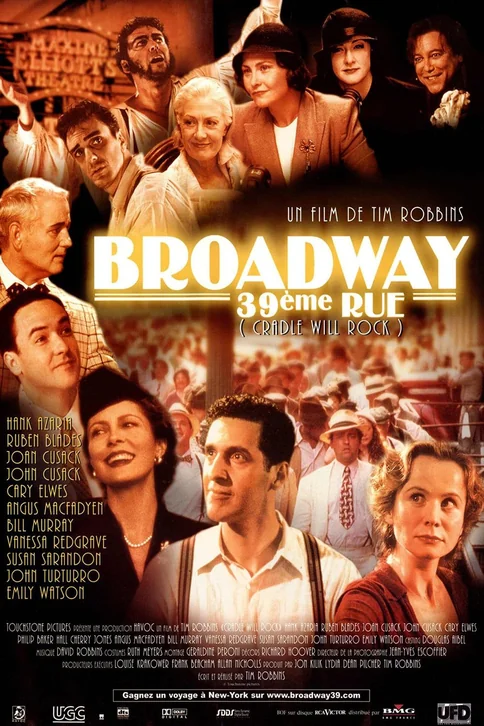🎯 Quick Overview
Trailer
- Director: Tim Robbins
- Genre: Drama, History, Musical
- Release year: 1999
- Runtime (length): 2h 12min
- IMDb rating: 6.7/10 (9.7K votes)
- Rotten Tomatoes: 62%
😅 Plot Summary – Badly Explained
In 1930s New York, a bunch of passionate artists try to put on a musical about steelworkers, but the government thinks it’s too ‘red,’ leading to a chaotic showdown involving an angry mural, a ventriloquist’s existential crisis, and a lot of people yelling about fascism.
🍿 Cradle Will Rock: Detailed Plot Synopsis
Depression-Era New York: A Nation in Turmoil
The film opens in 1930s New York, a city grappling with the profound economic hardships of the Great Depression. In response to widespread unemployment, President Franklin D. Roosevelt’s Works Progress Administration (WPA) establishes the Federal Theatre Project (FTP). This initiative aims to provide employment for out-of-work artists and deliver cultural enrichment to the public, offering a glimmer of hope amidst the era’s despair. However, this period is also marked by significant political unrest, with ideologies like Communism and Fascism gaining traction globally and dividing opinions domestically. The FTP soon finds itself under intense scrutiny from conservative factions within the U.S. Congress, who view its progressive themes and diverse personnel with suspicion, fearing ‘red’ influences and radical activity.
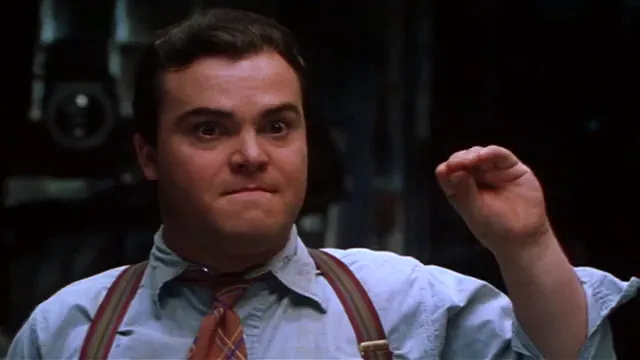
The Birth of a Controversial Musical: ‘The Cradle Will Rock’
At the heart of the Federal Theatre Project’s ambitious undertakings is the creation of ‘The Cradle Will Rock,’ a pro-union, anti-capitalist operetta by composer Marc Blitzstein. The play dramatizes the struggles of steelworkers attempting to unionize against powerful industrialists, resonating deeply with the economic realities faced by many Americans. Visionary young director Orson Welles and his producer John Houseman lead the production, pouring their artistic passion into bringing Blitzstein’s bold message to the stage. Their commitment, however, sets them on a collision course with external forces determined to silence any art deemed subversive.
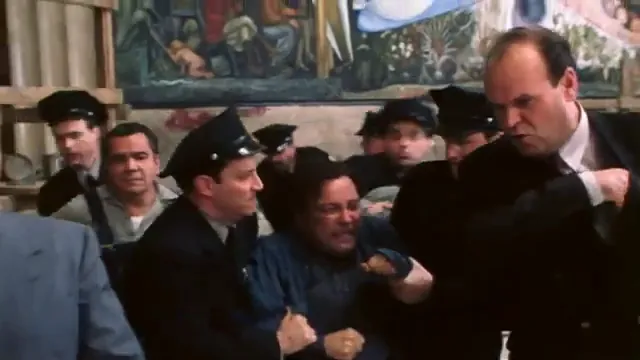
Artistic Freedom vs. Corporate Control: The Rockefeller Mural
Simultaneously, the film weaves in other narratives highlighting the clash between artistic integrity and economic power. Wealthy industrialist Nelson Rockefeller commissions renowned Mexican muralist Diego Rivera to create a grand mural for the lobby of the Rockefeller Center. The collaboration turns contentious when Rivera includes a portrait of Vladimir Lenin in his mural, a detail unacceptable to Rockefeller. This standoff underscores the film’s broader theme: the tension between an artist’s vision and the demands of their patrons, particularly when political ideologies clash.
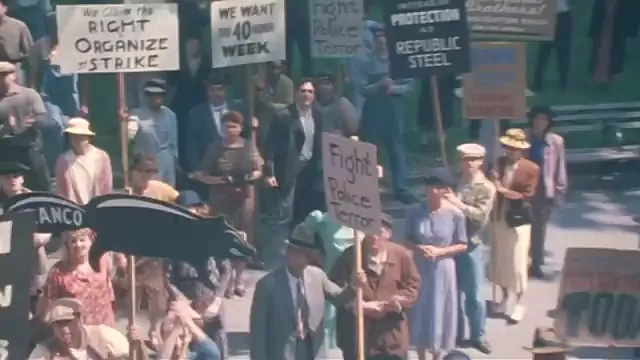
Converging Pressures: The Threat of Censorship
As the opening night of ‘The Cradle Will Rock’ approaches, the Federal Theatre Project faces mounting pressure and accusations of Communist sympathy from the Dies Committee in Congress. Despite the artistic merit and social relevance of the play, its pro-union stance and critical perspective on capitalism make it a prime target for those seeking to curb government-funded art. The looming threat of budget cuts and direct censorship hangs heavy over Hallie Flanagan, the head of the FTP, and her team, forcing them to confront difficult decisions about the future of their artistic endeavors and the very principle of free expression.

⚠️ Spoilers and Ending Explained
🎬 Cast & Characters
- Orson Welles (Angus Macfadyen): The ambitious young director determined to stage the controversial pro-union musical ‘The Cradle Will Rock’ despite government opposition.
- Marc Blitzstein (Hank Azaria): The passionate composer and writer of the anti-capitalist operetta ‘The Cradle Will Rock,’ battling censorship and artistic integrity.
- Hallie Flanagan (Cherry Jones): The principled head of the Federal Theater Project, fighting to protect artistic freedom against government interference and accusations.
- Nelson Rockefeller (John Cusack): The wealthy art patron who clashes with his hired artist over a controversial mural containing a depiction of Lenin.
- Diego Rivera (Rubén Blades): The renowned Mexican muralist who insists on artistic integrity by including a controversial figure in his commissioned work for Rockefeller.
- Margherita Sarfatti (Susan Sarandon): An influential Italian art dealer and cultural emissary for Mussolini, navigating the art world while promoting fascist interests.
- John Houseman (Cary Elwes): The pragmatic producer and collaborator with Orson Welles, working to get ‘The Cradle Will Rock’ staged under challenging circumstances.
💬 Memorable Quotes
- Orson Welles: “No one should be afraid of an idea!” – He defiantly declares this as the Federal Theatre Project faces pressure and eventual shutdown, emphasizing the importance of artistic freedom and challenging censorship.
- Diego Rivera: “I paint what I see, Mr. Rockefeller. And I see Lenin.” – Rivera firmly tells Nelson Rockefeller he will not remove the portrait of Lenin from his mural, asserting his artistic integrity against corporate censorship.
- Tommy Crickshaw’s Dummy: “Solidarity forever, Tommy! For the common man!” – In a surprising moment, Tommy’s ventriloquist dummy utters this pro-union slogan during a performance, revealing a hidden sentiment in the context of political suppression.
- John Houseman: “The show must go on! Even if it means performing it in the street!” – Houseman declares this with determination when the government locks the theater doors, embodying the spirit of defiance and commitment to getting the play staged.
💰Box Office
- Budget: $36,000,000
- Domestic Gross: $2,903,404
- Worldwide Gross: $2,986,932
💥 Cradle Will Rock Reviews
Personal Review
I absolutely loved ‘Cradle Will Rock’! This movie just grabbed me from the start with its incredibly rich atmosphere of 1930s New York. Seeing all those amazing actors, like John and Joan Cusack and Bill Murray, portray real historical figures felt so alive and authentic. I was particularly captivated by the struggle to put on the ‘Cradle Will Rock’ play; it really made you feel the passion and desperation of artists fighting for their voice. The scene where the actors stand up in the audience to perform, defying the union’s orders, gave me chills—it was such a powerful moment of defiance and unity. And the parallel story of Diego Rivera’s mural and Nelson Rockefeller’s reaction was fascinating, highlighting how art can truly challenge power. This film isn’t just a history lesson; it’s a moving testament to the enduring fight for freedom of expression, and it left me feeling incredibly inspired.
- Who would enjoy:
- “Viewers interested in historical dramas and the 1930s era.”
- “Fans of ensemble casts and director Tim Robbins’ previous works, such as ‘Bob Roberts’ and ‘Dead Man Walking’.”
- “Those intrigued by the intersection of art, politics, and social justice.”
- “Audiences interested in the early careers of iconic figures like Orson Welles and Diego Rivera.”
- “People who appreciate films that explore themes of artistic freedom, censorship, and labor movements.”
- Content warnings ⚠:
- “Strong political themes and social commentary, which some may find didactic or partisan.”
- “Depictions of economic hardship and social conflict during the Great Depression.”
- “Themes of censorship and ideological clashes.”
- “Rated 15 in the United Kingdom, indicating content that may be unsuitable for viewers under 15.”
Professional Reviews
- FilmPulse Magazine: “Tim Robbins orchestrates a masterful historical tapestry in ‘Cradle Will Rock,’ bringing to life the turbulent 1930s with an incredible ensemble cast. It’s a vibrant, ambitious piece that bravely explores the intersection of art, politics, and censorship. While its multiple storylines could feel disjointed, Robbins skillfully weaves them into a compelling narrative that celebrates artistic integrity. A thought-provoking and exhilarating experience.
- The Cinematic Observer: “‘Cradle Will Rock’ is a dazzling, Altman-esque journey into a pivotal moment in American history. The sheer talent on screen, from Bill Murray’s poignant puppeteer to Cherry Jones’s formidable Hallie Flanagan, elevates an already compelling story. Robbins’ direction is both meticulous and energetic, delivering a timely reminder of the power of artistic expression against formidable opposition. It’s an intelligent and passionate film.
Audience Reactions
Viewers were captivated by the film’s sprawling, star-studded ensemble cast and its vibrant depiction of a pivotal historical era.: Audiences praised its ability to intertwine complex historical events with personal stories, creating a deeply engaging and thought-provoking experience that champions artistic freedom and social justice.
Many found the film’s exploration of censorship and the unwavering spirit of the artists profoundly inspiring.: The final, defiant performance of the play, with actors standing in the audience, resonated deeply with viewers as a powerful symbol of artistic integrity triumphing over adversity.
Overall Consensus: Cradle Will Rock is widely praised as an ambitious and brilliantly acted historical drama that masterfully weaves together multiple narratives to deliver a powerful message about art, politics, and the enduring fight for freedom of expression.
Awards
🛠️ Behind the Scenes
- “The film dramatizes real historical events, but Tim Robbins took significant liberties with the timeline, condensing and combining events that were actually years apart (e.g., Diego Rivera’s mural controversy happened in 1933, while the ‘Cradle Will Rock’ play incident was in 1937).”
- “Despite its star-studded ensemble cast, many actors reportedly worked for significantly reduced fees or even for free as a show of support for writer/director Tim Robbins and their passion for the film’s themes of artistic freedom and social justice.”
- “The historical event central to the film involved Actors’ Equity, the union representing stage performers, paradoxically threatening its own members with expulsion if they participated in the ‘Cradle Will Rock’ performance, despite the play’s pro-union message.”
- “Director Tim Robbins deliberately employed a cinematic style influenced by Robert Altman, utilizing a large ensemble cast and intricate, often long, tracking shots to weave together multiple intersecting storylines and characters.”
🖥️ How to Watch Cradle Will Rock?
As a film from 1999, ‘Cradle Will Rock’ is widely available for digital purchase or rental. You can find it on major platforms such as Prime Video, Apple TV, Google Play, and YouTube. For physical media collectors, DVD copies are also available from various online retailers.
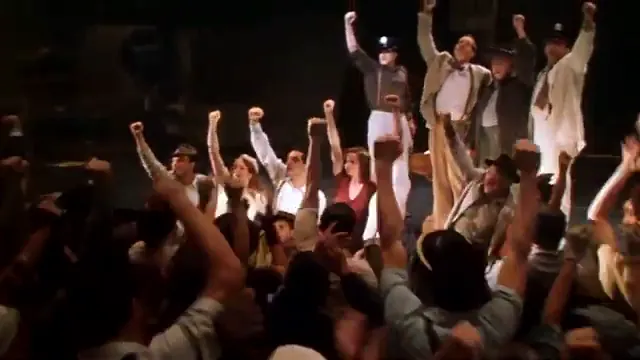
🎥 Similar Movies
If you enjoyed Cradle Will Rock, you might like these similar films:
- Bob Roberts (1992): Also written and directed by Tim Robbins, it’s a sharp political satire that critiques media manipulation and political performance, echoing the socio-political themes and stylistic choices of ‘Cradle Will Rock’.
- Good Night, and Good Luck. (2005): This film chronicles Edward R. Murrow’s confrontation with Senator Joseph McCarthy, sharing ‘Cradle Will Rock”s themes of artistic and journalistic integrity battling political suppression during a volatile historical period.
- The Grapes of Wrath (1940): Set during the Great Depression, this classic vividly portrays the struggles of the working class and themes of solidarity and resilience in the face of economic hardship, similar to the labor themes in ‘Cradle Will Rock’.
- The Post (2017): Featuring a large ensemble cast, this film explores the conflict between press freedom and government power, resonating with ‘Cradle Will Rock”s focus on censorship and the fight for expression against powerful institutions.
- Nashville (1975): Directed by Robert Altman, this film is a seminal example of ensemble storytelling with multiple intersecting narratives and rich social commentary, a style that Tim Robbins openly cites as an influence on ‘Cradle Will Rock’.
🛒 Cradle Will Rock Related Products
- The Cradle Will Rock (Original Broadway Cast Recording – Digital Album): Immerse yourself in the powerful music of Marc Blitzstein’s groundbreaking opera. This digital album features the original Broadway cast recording, capturing the raw energy and controversial spirit of the 1937 production.
- Orson Welles ‘Citizen Kane’ Funko Pop! Figure (Young Welles): A collectible vinyl figure depicting a young Orson Welles, referencing his early career pivotal to the movie, and foreshadowing his iconic ‘Citizen Kane’ work.
- Federal Theatre Project: A Global Survey (Hardcover Book): A comprehensive historical account detailing the Works Progress Administration’s Federal Theatre Project, its aims, controversies, and lasting impact on American performing arts during the Great Depression.
- ‘Art for the People’ Vintage Design T-Shirt: A comfortable cotton t-shirt featuring a vintage-inspired design with the slogan ‘Art for the People,’ reminiscent of 1930s WPA posters and the film’s pro-art message.
🎧 Soundtrack
Cradle Will Rock features a captivating soundtrack that enhances the movie’s atmosphere and emotional impact. Here are some notable tracks:
- “The Cradle Will Rock (Main Theme)” – performed by Marc Blitzstein
- “Let’s Do Something” – performed by Marc Blitzstein (Performed by Erin Hill and Daniel Jenkins)
- “Union Dues” – performed by Marc Blitzstein
- “Steel Town Blues” – performed by Marc Blitzstein
You can find the complete soundtrack on Amazon Music and Apple Music.
🤨 FAQ
Yes, ‘Cradle Will Rock’ is based on actual historical events from the 1930s, specifically the controversial 1937 production of Marc Blitzstein’s operetta ‘The Cradle Will Rock’ by Orson Welles and John Houseman under the Federal Theatre Project. It also incorporates the true story of Diego Rivera’s mural at Rockefeller Center, though it takes artistic liberties with some details and timelines for dramatic effect.
The film features a large ensemble cast portraying numerous prominent historical figures. Key characters include Marc Blitzstein (composer), Orson Welles (director), John Houseman (producer), Hallie Flanagan (head of the Federal Theatre Project), Nelson Rockefeller (patron), Diego Rivera (painter), and figures representing different social strata and political viewpoints of the era.
The central theme of ‘Cradle Will Rock’ revolves around the inherent struggle between artistic integrity and external control, particularly from political and economic forces. It explores the vital role of art as a medium for social commentary and change, highlighting the fight for free expression, the impact of censorship, and the power of collective action during a period of intense ideological conflict and economic hardship.
In a climactic act of defiance, after the government locked down the original venue, the play ‘The Cradle Will Rock’ was performed in a spontaneous, unauthorized manner. Orson Welles, John Houseman, and Marc Blitzstein relocated to another theater, where, adhering to Actors’ Equity rules that prohibited actors from performing on stage, the cast bravely performed their roles from their seats in the audience, with Blitzstein accompanying them on a piano on stage. This unconventional premiere became a symbol of artistic freedom.
🔥 Bonus Content
THE CRADLE WILL ROCK – The True Story
Ever wondered about the real story behind that incredible movie ‘Cradle Will Rock’? This video has John Houseman himself spilling the beans on the chaotic opening night of the original 1937 musical – it’s fascinating to see how the government tried to shut it down!
✨ Rate
There are no reviews yet. Be the first one to write one.


